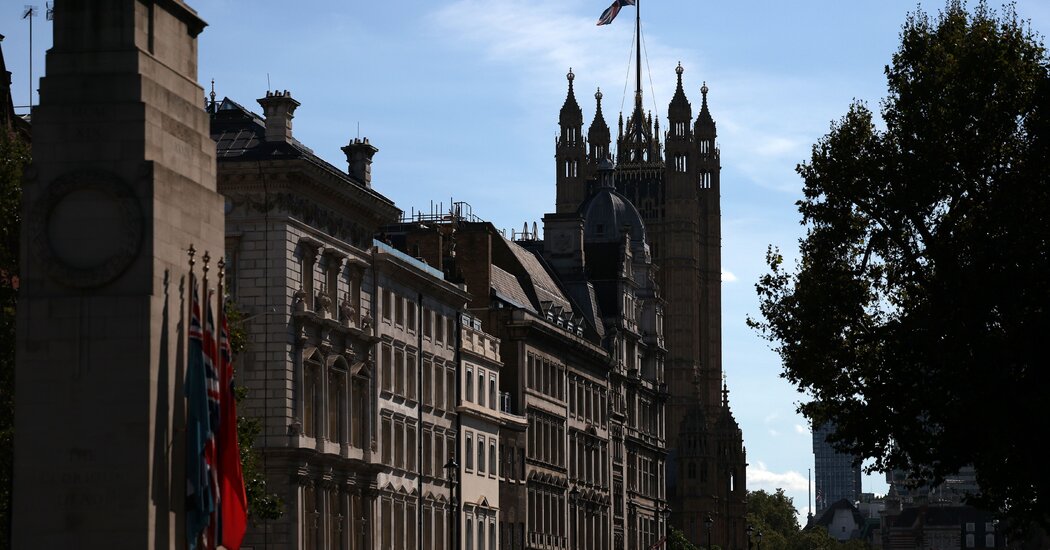Europe Rushes to Build Defenses But With Little Consensus on How
At Saab’s sprawling combat production center in Karlskoga, Sweden, the 84-millimeter shells that can take out a battle tank in a single stroke are carefully assembled by hand. One worker stacked tagliatelle-shaped strips of explosive propellant in a tray. Another attached the translucent sheafs around the rotating fins of a guiding system.
Outside the squat building, one of hundreds in the guarded industrial park, construction is underway on another factory. Capacity at this plant — a few minutes’ drive from the home of Alfred Nobel, the inventor of dynamite and founder of the peace prize — is scheduled to more than double in the next two years.
The enlargement is part of a titanic expansion in military spending that every country in Europe has undertaken since Russia invaded Ukraine 18 months ago. Yet the mad dash by more than 30 allied countries to stockpile arms after years of minimal spending has raised concerns that the massive buildup will be disjointed, resulting in waste, supply shortages, unnecessary delays and duplication.
“Europeans have not addressed the deeply fragmented and disorganized manner in which they generate their forces,” a recent report from the Center for Strategic and International Studies said. “Investing more in an uncoordinated manner will only marginally improve a dysfunctional status quo.”
Still, a growing chorus of weapons manufacturers, political figures and military experts warn the efforts fall far short of what is needed.
“There needs to be some clarity since we’re not the United States of Europe,” Micael Johansson, the president and chief executive of Saab, explained from the company’s headquarters in Stockholm. “Every country decides themselves what type of capabilities they need.”
Each country has its own strategic culture, procurement practices, specifications, approval processes, training and priorities.
Alliance members may sometimes use the same aircraft but with different encryption systems and varying instruments. As Ukrainian soldiers have discovered, 155-millimeter shells produced by one manufacturer do not necessarily fit into a howitzer made by another. Ammunition and parts are not always interchangeable, complicating maintenance and causing more frequent breakdowns.
The European Union does not “have a defense planning process,” said Mr. Johansson. This summer, he was appointed vice chairman of the board at the Aerospace and Defense Industries Association of Europe, a trade association representing 3,000 companies. “NATO has to rethink how do we create resilience in the whole system,” including supply chains that produce the munitions soldiers use on the battlefield.
Crucial raw materials like titanium and lithium, as well as sophisticated electronics and semiconductors, are in great demand.
And there is a shortage of explosives, particularly powder, which manufacturers across the entire weapons industry depend on. But there has been little detailed discussion about which systems should get priority or how the supply of powder as a whole could be increased.
“I suggested it,” Mr. Johansson said, “but it hasn’t happened yet.”
The discussions are taking place at a time when the resilience of far-flung supply chains of all kinds are being re-examined. Memories are still fresh of interruptions in the flow of natural gas and grain resulting from the war in Ukraine, not to mention the severe backlogs in the production and delivery of goods and materials caused by the Covid pandemic.
The big trend now, said Michael Höglund, head of business area ground combat at Saab, is to bring supply chains closer to home and to create reliable backups. “We’re no longer buying the cheapest,” he said. “We’re paying a fee to feel safer.”
Coordinating supplies is just one element. Getting a jumble of varying weapons systems, practices and technologies to smoothly perform in concert has always been a challenge. NATO has set standards so that the different systems are compatible — what is known as interoperability.
The practice, though, can be less than harmonious.
The European Defense Agency’s annual review last year found that only 18 percent of defense investments are done together, half of the targeted amount. “The degree of cooperation among our armies is very low,” Josep Borrell, the European Union’s top diplomat, said at the time.
Sweden is on the cusp of joining NATO, but it has partnered with the military alliance before, and Saab, which produces a range of weapons systems including the Gripen fighter jet, sells to scores of countries around the world.
Managers there have seen some of the challenges to coordination up close in large and small ways.
“The whole system in each army is built up in a special way,” said Gӧrgen Johansson, who oversees the Karlskoga operation. (He is not related to the chief executive.) Behind him sat an empty green tube used to launch Saab’s shoulder-fired NLAW anti-tank missile. It was signed by Ukraine’s former minister of defense and returned to its maker as a token of appreciation.
Some customers, he said, want two launchers packed in a single box, another wants four, or six, because they have bought vehicles and equipment that can hold different numbers of launchers.
Mr. Johansson said that until very recently, it was impossible to get the players to even talk about standardizing where labels were positioned or what color they should be.
Bigger problems remain. After the Cold War ended, there was an enormous consolidation of defense companies as military spending shrank. Still, like varying brands of cereal, there is a wide range of each major weapons system. Europe has 27 different types of howitzers, 20 types of fighter jets and 26 types of destroyers and frigates, according to an analysis by McKinsey & Company.
In building a unified fighting force, Europe must balance competition, which can result in improvements and innovation, with the need to eliminate waste and streamline operations, by ordering or even designing weapons in concert.
Underlying the once-in-a-generation military expansion is that the continent is still primarily dependent on the United States for its safety. President Trump’s complaints in 2018 of insufficient spending in Europe and veiled threats to withdraw from NATO profoundly shook the region.
But the view that Europe has to take more financial responsibility for its own defense is now widespread, urgently ratcheting up the pressure to better unify Europe’s defenses.
Coordination, though, faces several built-in hurdles. As the center’s report concluded, integrating European defense “will be a slow laborious process and a generational effort.”
Governments are already funneling millions or billions of dollars to defense and, naturally, every one wants to support its own industries and workers.
And whatever Europe’s overall defense needs may be, each nation’s first priority is protecting their borders. There is limited trust even among alliance members.
“We think we are friends,” said Gӧrgen Johansson in Karlskoga. But he noted that during the pandemic when there was a shortage of ventilators, Germany, which had a surplus, stopped supplying them to Sweden, Italy and other countries in need.
“The talks have started,” Mr. Johansson said of efforts to improve coordination. “Do I think it will go quickly? No.”


